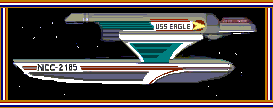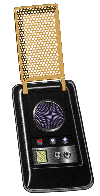The USS Eagle, NCC 2185,

A Star Trek Sim / Star Trek RPG
Presents....
OUR STAR TREK SIM GUIDE SERIES
STAR TREK SIM HELM AND PILOT GUIDE

BASIC HELM
 Types of propulsion:
Types of propulsion:| Term |
Definition |
| Impulse |
Used for speeds lower than
the speed of light, also called the sublight |
| Thrusters |
Used for manuevering and for
lift off. |
| Warp |
Used
for faster than light speeds. |
 Location(with respect to your ship):
Location(with respect to your ship):| Term |
Definition |
| Aft |
Behind |
| Foreward |
Toward the bow or front of
the ship |
| Starboard |
Right |
| Port |
Left |
 Directions:
Directions:There are two types of directions commonly given in Star Trek; Mark and Bearing. (Images and animations will be added here later.)
------Relative Bearing- The direction of your ship with respect to the ship's heading (bow)
------Absolute Bearing- The direction of your ship in relation to a particular reference point. In Star Trek, the "Center of the Galaxy" is used.
NOTE: Depending on your point of view, the three axis belonging to three dimensional space can be labled differently. Here we use scientific convention first and military convention in parenthesis. This way you can recognize both. Images and animations will be added here later to help clarify the descriptons. It may be easier for people without any background in either to look at the ship labeling of axis instead of the x, y and z versions. The difference is between which axis is labeled y and which os labled z. In scientific convention: X is left right, Y is up down and Z is in-out.
 Types of motion of ship (not always desired ;o) )(Images and animations will be added here later.) :
Types of motion of ship (not always desired ;o) )(Images and animations will be added here later.) :
| Term |
Definition |
Related Term |
Description |
| Pitch |
Rotation about the x-axis |
X axis: imaginary horizontal
line in the left-right direction, port to starboard axis |
Think of it as a sort of sommersault motion. |
| Roll |
Rotation about the z-axis (y- axis) |
Z axis (Y axis): imaginary in-out line direction, from bow to stern axis of the ship |
Think of it as spinning like a cartwheel |
| Yaw |
Rotation about the y-axis (z- axis)
|
Y axis(Z- axis) : imaginary vertical line in the up-down direction, from top to bottom axis of the ship |
Think of it as spinning like a top |
 Phrases related to space battles or fighting
Phrases related to space battles or fighting| Term |
Definition |
| Engage |
Begin fighting with another
ship |
| Disengage |
Break
off fighting with another ship |
 Types of Pursuit:
Types of Pursuit:| Term |
Definition |
| Lead pursuit |
Taking the path based on your
prediction of the flight path of your target. You anticpate where it will
be and alter your course to cross the target's flight path.Smaller or more
manueverable craft can get an advantage by taking sharper turns. |
| Lag pursuit |
The opposite of lead pursuit.
You make a wider turn instead of a sharper one to a point just behind the
tail of the target. |
| Pure pursuit |
Following
closely the path of the target.This is the position you want to be in for
for torpedo and missile firing. Good also for closer range with phasers. |
 Fun stuff:
Fun stuff:| Term | Definition |
| Slingshot effect |
Use it to catapult around a
star or planet by using the force of its gravitional pull and veer off at the right moment.This is great for escaping crashing into the planet with little or no power and just the use of thrusters at the last (and right) moment. If you do it just right around a star you can travel back in time (according to the original series and the original series movies) and reek havoc with the time line. |
Visit the main page of our Star Trek sim

Click here to contact us via the communicator
OR
Join our Star Trek Sim, based on the Original Series (TOS)!

Star Trek Sim Medical Dictionary for Injuries: Burns
Star Trek Sim Medical Dictionary for Drugs
Star Trek Sim Medical Dictionary for Devices
Online Medical Resources (Scroll to medical section)
Star Trek Sim Medical Stories: Trick or Treatment
Star Trek Sim Medical Stories: Thalessmia
Star Trek Sim Medical Stories: Doctor Dilemma
Star Trek Medical Buddy Icons
CMO Quarters
AMO Quarters
Cartoon Sickbay
Cartoon Monitor
Star Trek Sim Guide Links:
Star Trek Sim Guides: Helm
Star Trek Sim Guides: Advanced Helm and Fighter Pilot
Star Trek Sim Guides: Space Battles
Star Trek Sim Guides: Weapon Commands
Star Trek Sim Guides: Combat Rules
Star Trek Sim Guides: Dice
Star Trek Department Links:
Star Trek Departments and Departmental Logos
Other Star Trek Departments: Engineeering
Other Star Trek Departments: Science
Other Star Trek Departments: Security

Wanted!
KLINGONS!
1)For simming against in the days of TOS2)For a DS9 Era Klingon Sim with an honorable ancient Klingon House
GO TO Klingon House: tuq qimat
PARENTS AND CHILDREN!
Attention Parents-STAR TREK RPG FORMING FOR YOUNGER SIMMERS:
The USS Eaglet NCC 008-013 is now forming. If you would like your children (ages 8 to 13) to sim in a totally G rated environment, please contact me at NouriKemat@aol.com . This Star Trek Sim will be based on the Original Series movie era just like the USS Eagle but will be totally geared toward a younger audience. We will be teaching them how to sim, team work and some science. Parents are welcome to join and sim along side their children
